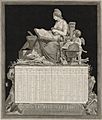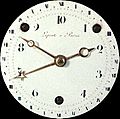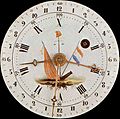French Republican Calendar facts for kids
The French Republican calendar (also known as the French Revolutionary calendar) was a special calendar used by the French government. It was used for about 12 years, from late 1793 to 1805. The Paris Commune also used it later in 1871. This calendar was created to remove all religious and royal (king-related) influences from the old calendar. It was also an attempt to make time work using a decimal system, which means based on units of ten.
Contents
Why a New Calendar?
The French Revolution brought many big changes to France. Leaders wanted to create a new society. They felt the old calendar reminded people too much of kings and the church. So, they decided to make a brand new calendar. This new calendar would show that France was starting fresh. It would also be based on reason and nature, not old traditions.
How the Republican Calendar Worked
The Republican calendar was very different from the one we use today.
- New Start Date: The year started on the autumn equinox. This is the day when day and night are about equal length in autumn. The first year, Year 1, began on September 22, 1792.
- Months and Days: There were 12 months, each with 30 days. This made 360 days in total.
- Extra Days: To make up the remaining days of the year (usually 5 or 6), there were special "complementary days." These days were added at the end of the year. They were often celebrated as festivals.
- Weeks of Ten Days: Instead of seven-day weeks, the calendar had "décades" (decades). Each décade had ten days. This was part of the plan to make everything decimal. The days of the décade were numbered, like "first day," "second day," and so on.
- Decimal Time: Some people also tried to make time decimal. This meant a day would have 10 hours instead of 24. Each hour would have 100 minutes, and each minute 100 seconds. This idea was not used as widely as the new calendar itself.
Naming the Months
The names of the months were very poetic. They were inspired by nature and the seasons in Paris.
- Autumn Months:
- Vendémiaire (Grape Harvest)
- Brumaire (Mist)
- Frimaire (Frost)
- Winter Months:
- Nivôse (Snow)
- Pluviôse (Rain)
- Ventôse (Wind)
- Spring Months:
- Germinal (Seed)
- Floréal (Flower)
- Prairial (Meadow)
- Summer Months:
- Messidor (Harvest)
- Thermidor (Heat)
- Fructidor (Fruit)
Each day of the month also had a special name. These names were often plants, animals, or farming tools. This was another way to connect the calendar to nature.
When the Calendar Was Used
The French Republican calendar was officially used from October 24, 1793. It was used throughout the French First Republic. However, it was quite different from the traditional calendar. Many people found it hard to get used to. It also made it difficult to communicate with other countries. Most other nations still used the Gregorian calendar.
Napoleon Bonaparte eventually ended the use of the Republican calendar. He brought back the Gregorian calendar on January 1, 1806. This was part of his effort to bring stability back to France. The calendar was briefly used again during the Paris Commune in 1871.
Images for kids
-
French Revolutionary pocket watch showing ten-day décade names and thirty-day month numbers from the Republican Calendar, but with duodecimal time. On display at the Musée d'Art et d'Histoire (Neuchâtel) In Switzerland.
See also
 In Spanish: Calendario republicano francés para niños
In Spanish: Calendario republicano francés para niños









